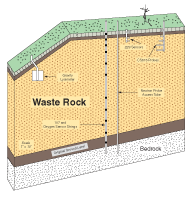


硬岩金属採掘に伴う酸性岩排水 (ARD) の問題は、多くの採掘作業にとって最大の環境課題の 1 つです。ARD の形成には、酸素、水、反応性岩 (鉱山の廃岩廃棄場内によく見られる) の 3 つの要素が必要です。ARD 防止戦略は数多くありますが、通常は、反応性廃岩への水と酸素の流入と反応性廃岩を通過する水と酸素の流入を最小限に抑えて、硫化物の酸化を減らすことに重点を置いています。一般的で効果的な手法は、反応性廃棄物を低浸透性のキャップと植物で覆い、反応性岩を酸素と水から隔離することです。このようなキャップの効果は、廃岩内の水の動き、酸素含有量、温度を監視することで、現場で評価できます。
モンタナ州ボーズマンの Schafer & Associates は、10 年以上にわたって廃石キャップの性能と関連する ARD の発達を監視してきました。これらの監視活動の不可欠な部分として、再生材料の水分含有量と温度変化をさらに特徴付ける CSI 機器が含まれています。通常、監視センサーは、キャップ システムとその下の廃石内の垂直プロファイルに沿って設置されます。各センサーは、継続的なデータ収集のために、地表にある CSI データロガーに接続されています。データの有用性を最大限に高めるために、通常は地表気象ステーションを設置して、キャップの性能に直接影響を与える可能性のある降水量や周囲条件の変化を監視します。図は、鉱山廃石施設の一般的な計測監視ネストを示しています。
地下水含有量と動きは、中性子ロギング、時間領域反射率測定法、重力ライシメータ、放熱ユニットなど、さまざまな技術と装置設計で監視できます。さまざまなキャップシステムによる水流の解釈を強化するために、上記の技術を組み合わせて使用できます。たとえば、Schafer & Associates は、CSI の 229-L 放熱マトリックス ポテンシャル センサーを効果的に使用して、植生カバーの下の低透水性バリア層で構成される多層キャップ システム内の水の変化を監視しています。低透水性層の真上と真下に放熱センサーを設置することで、浸透を制限するバリアの効果を評価できます。また、これらのセンサーはバリア層の湿潤度を示し、キャップのパフォーマンスに悪影響を与える可能性のある傾向を示します。
廃石材料の水分含有量の変化を監視するもう 1 つの効果的な手法は、CS615 水分含有量反射計プローブです。CS615 は、手つかずの廃石山の上部表面に水平に設置され、山への水分流入に関するベースライン情報を提供します。植生のあるキャップで再生した後、植生が定着する間、CS615 を使用して廃石への純表面水分流入を監視できます。収集されたデータにより、植生キャップの性能を評価できるだけでなく、水収支モデルの入力パラメータも強化されます。
ARD の形成中、廃石材料中の黄鉄鉱の酸化は発熱反応です。黄鉄鉱が硫酸鉄と酸に酸化されると、1440 kJ mol -1の黄鉄鉱が生成されます (Harries and Ritchie 1981)。Schafer & Associates は、CSI の 107 個の温度プローブを使用して、キャップされた廃石山の垂直プロファイル全体の温度変化を監視しています。傾向分析技術と監視データを使用することで、ARD の発達と構築されたキャップのパフォーマンスの両方を評価できます。
再生された廃石山を監視することは、建設されたキャップの性能を評価する上で重要なツールです。継続的な監視技術から生成されたデータにより、キャップと廃石材料内で発生する水の動きと潜在的な反応をより正確に解釈できます。CSI 機器は、ARD を制限するための工学的制御の監視と評価において、これまでも、そしてこれからも、重要な役割を果たし続けます。